Photos taken by Isabelle Shiiba (Brandeis University), Student Correspondent for CET Japan, Spring 2023
Nara, Kyoto, Osaka, Mie, oh my! It feels like there’s an infinite list of places to visit while living in Japan, and recently I’ve been caught up taking full advantage of every opportunity CET has to offer. As a CET student, we have day trips and overnight trips arranged for us, as well as university-related events and the liberty to explore and travel on our own. Let me walk you through my recent adventures in Japan!
CET Trips: Cup Noodle Museum & Kyoto
The nice thing about CET arranged trips is that transportation is free, activities are included, and the itinerary is planned for you– I just had to show up! So far as a program, we have visited the Cup Noodle Museum in Osaka, and Toei Uzuma Eigamura and Arashiyama in Kyoto. We took a day trip to the Cup Noodle Museum, a must-see in Osaka, and made our own customized cup noodles! The museum was very interactive and taught us the history of the instant noodles while also demonstrating how it is made. My customized cup noodles was a curry instant noodle with corn, fish cake, egg and chicken!
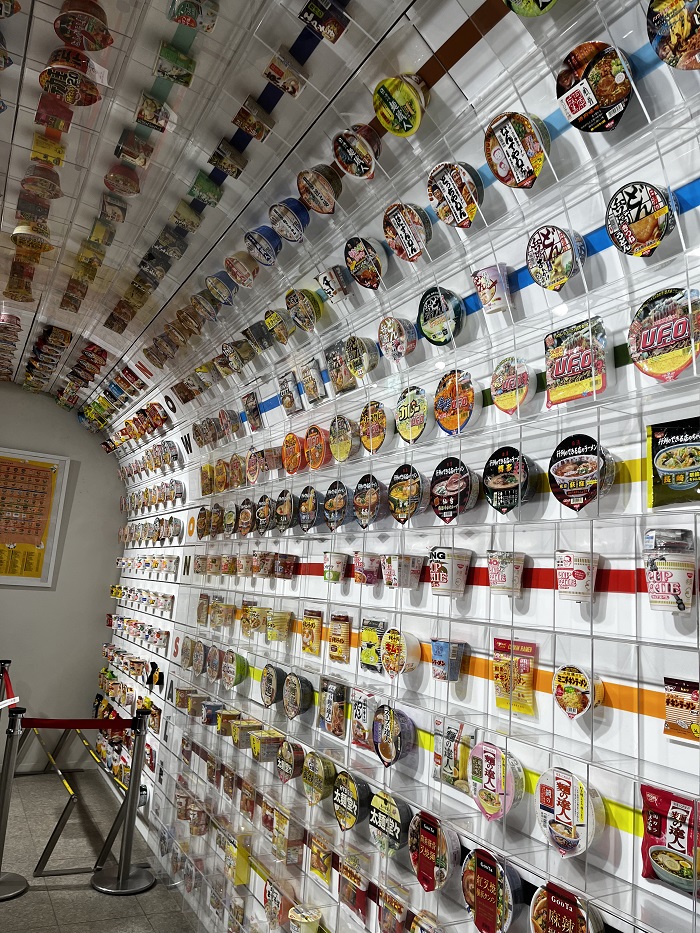
Wall inside the Cup Noodle Museum in Osaka.
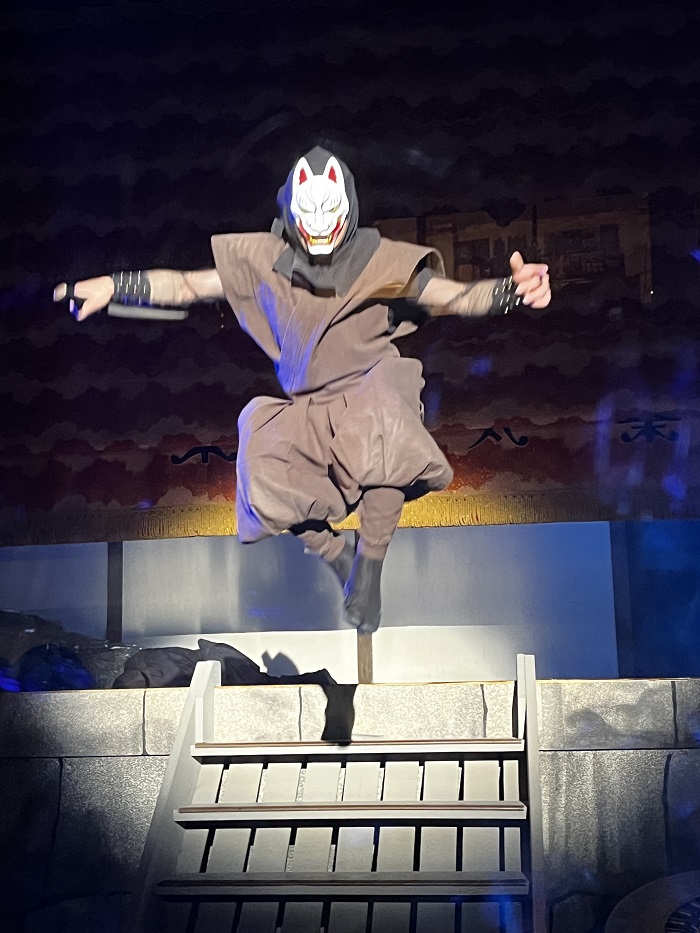
Our second trip thus far was to Kyoto! We first visited the Toei Uzuma Eigamura, a theme park and film set modeled after the Edo Period in Japan. Actually, a lot of movies have been filmed there and it really looked like old Japan! My favorite part of the visit was watching the samurai show in the front row; the agility of the samurai was amazing to watch!
I also went through a haunted house that was much scarier than I anticipated. My friends and I latched onto each other as if the haunted dolls would snatch us up all together.
After the Eigamura, we all made our way to Arashiyama in Kyoto, at the base of the Arashiyama Mountains. We took a huge CET group picture in the famous mountain grove and then we all were given some money to explore, buy snacks or do different activities in the area. My friends and I went up to the Arashiyama Monkey Park and fed wild monkeys while watching a beautiful view of Kyoto. Baby monkeys were riding on their mothers backs, other monkeys were checking each other’s hair, sitting watching over us or looking cute so we could feed them– I could’ve spent the whole day just watching them.
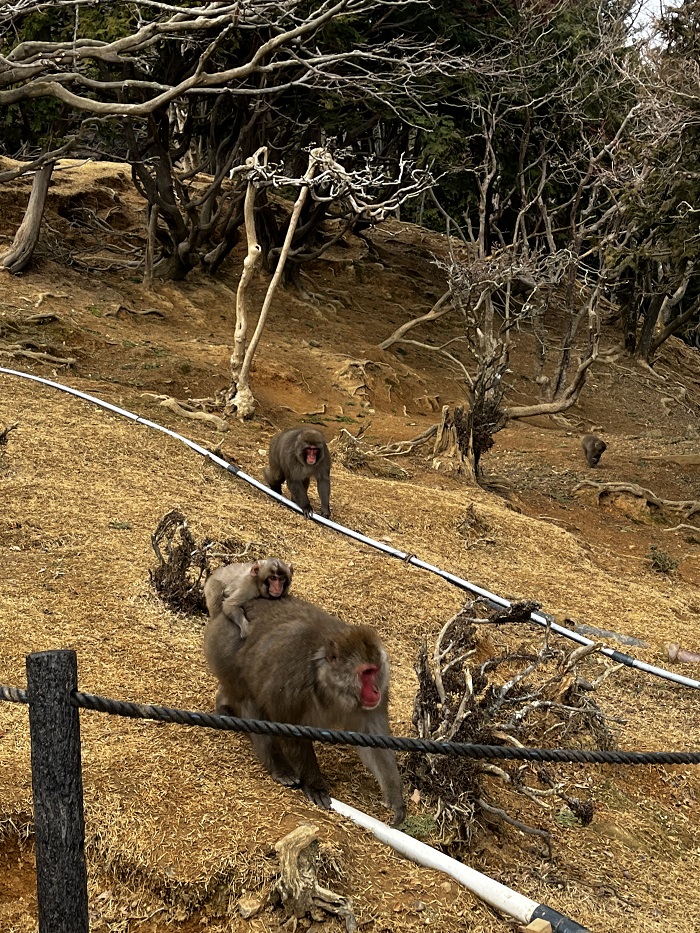
Baby monkey riding the back of mother monkey in Arashiyama Monkey Park, Kyoto.
Religion Class Field Trips: Festival & Burial Mound
Aside from my daily Japanese class, I am taking an elective called “Religious Identity in Modern Japan”. A main component of my religion class is to go on field trips to watch and participate in Japanese religious activities to get a hands-on experience of what we’re learning. These field trips have become a highlight of my time in Japan because I’m able to experience local activities that a common tourist wouldn’t visit.
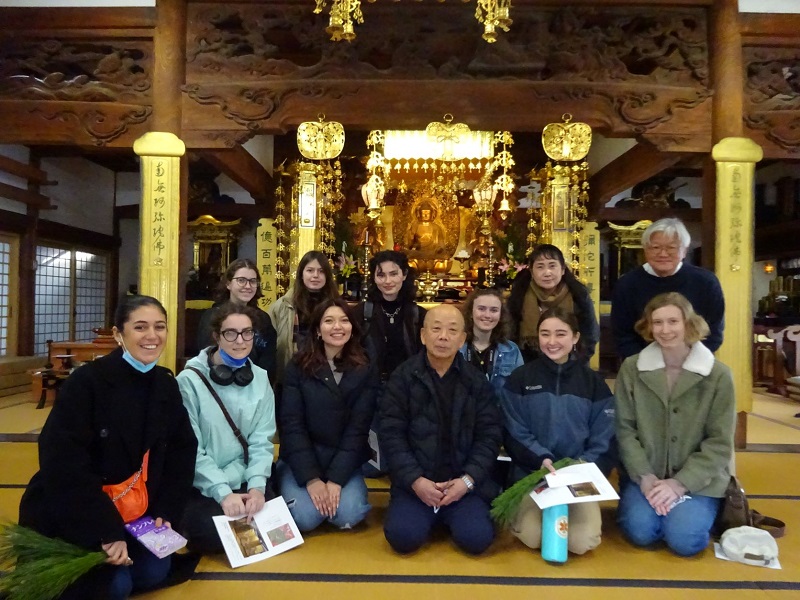
Our religion class, sensei, and local priests inside a Buddhist temple in Towaramoto, Nara.
Our first trip was to Towaramoto, Nara where we watched a rice-planting festival (Onda matsuri) at a local Shinto shrine called Muraya Jinja. This ritual was so special to watch because it demonstrated such an intimate relationship that the local Japanese farmers had with the land while also being an extremely welcoming environment for anyone to participate in.
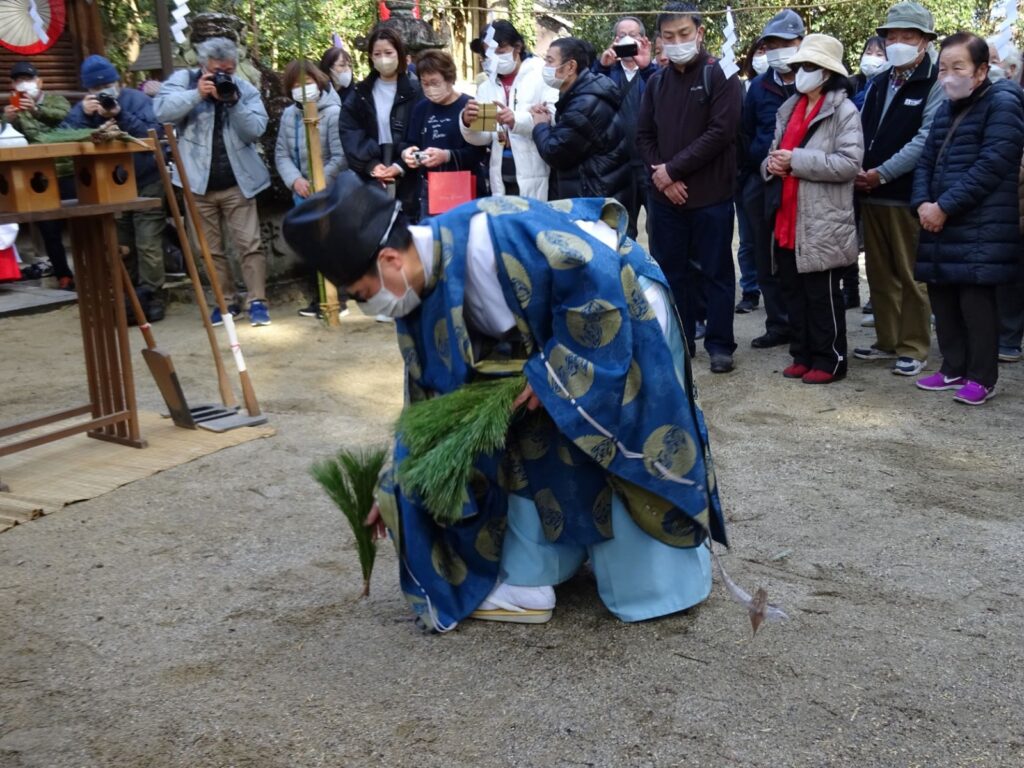
Shinto priest re-enacting rice-planting during the Onda Matsuri, rice-planting ritual in Towaramoto, Nara.
My classmates and I received blessed pine tree branches and mochi from the Shinto priest, as well as met the kagura dancers. We were even welcomed to a local farmer’s Japanese home and shown around Towaramoto after the festival. I learned so much about the significance of rice and rice planting through this field trip and met wonderful people as well. I was extremely moved and my friends and I plan to return soon to learn more about kagura dancing, as well as learn how to dance it.
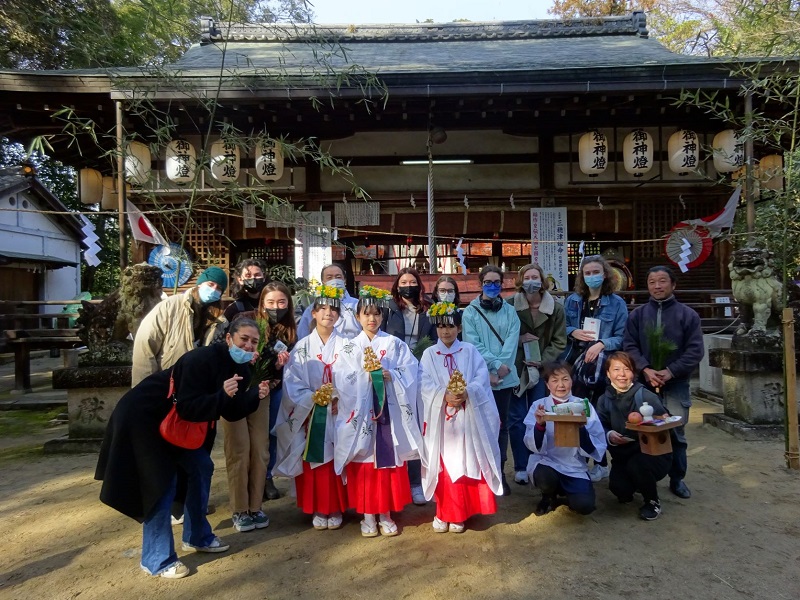
Our religion class, kagura dancers, and local Nara farmers in front of Muraya Jinja after the Onda Matsuri.
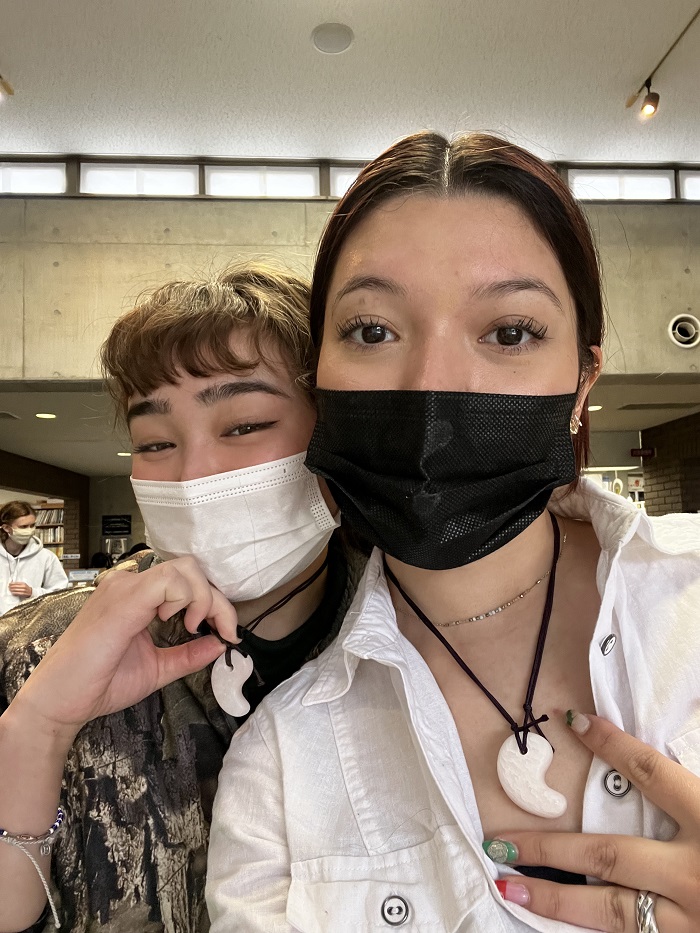
Our second trip and most recent trip so far was to Shionjiyama Kofun, a burial mound made during the Kofun Period (~ 5th century CE) in southeast Osaka. There we made magatama necklaces made of stone before walking around the kofun. Magatamas are a comma shaped stone, originally made of Jade, and is religiously significant in Japan; the magatama is one of three Imperial Regalia in Japan. In fact, the person buried in this kofun was found to be wearing a magatama, signifying that they were probably a ruler in the area and led religious rituals– although they were never identified.
After we made magatamas, we walked around the grand, key-hole shaped kofun and observed the different types of clay figurines called haniwa, around the burial mound. It was amazing to see such a well kept preservation of a prehistoric Japanese burial mound that only held 3 people at the time.
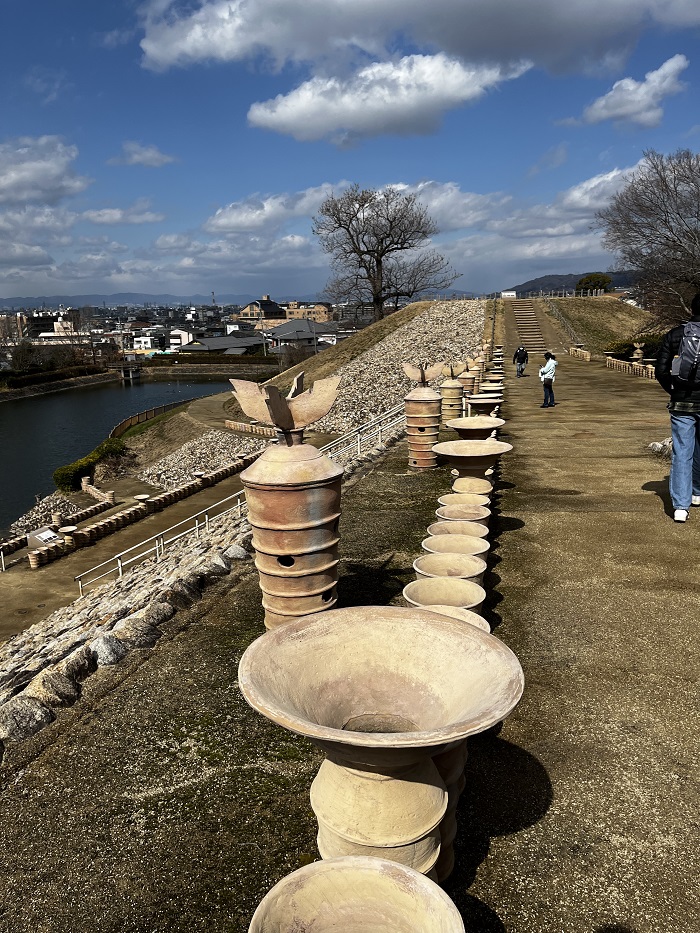
Shionjiyama Kofun, an ancient burial mound made during the Kofun Period. This key-shaped kofun displayed many haniwa and was surrounded by a moat.
Friend Trips: Kyoto, Nara and Mie
My last category of recent adventures has been trips with friends! On a day off from school, my friends and I hiked up the Daimonjiyama Mountain in Kyoto. The hike was quite steep but a great workout with a spectacular view. I felt like we were floating in the clouds at times or lost in a vast forest while hiking. It was beautiful.
Before my first religion class field trip, a friend and I visited Nara Park to make friends with the local deer. Here, deer roam freely, chase you down if you have biscuits in your hand, and relax in the sun once they’re full. It was amazing to see so many cute deer interact with people. I even saw a man playing a french horn and called dozens of deer for a midday feeding! It is said that deer are sacred messengers of the gods (kami), according to Shinto beliefs. Thus, I believe this is why the people of Nara take such good care of the wild deer.
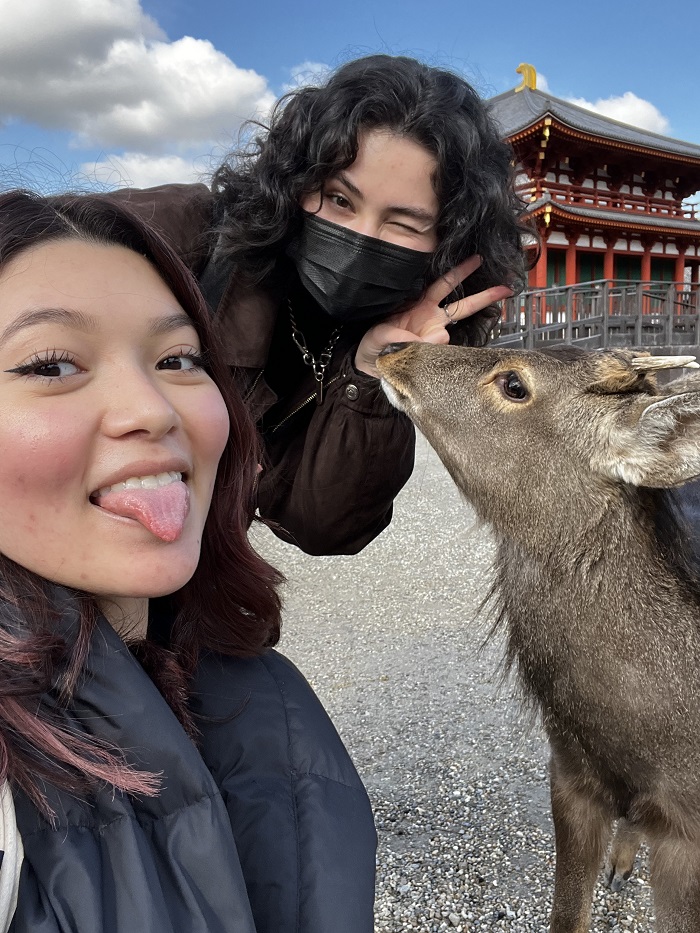
Deer posing with us or checking to see if we have food?
Most recently, I visited a prefecture called Mie, about a 2.5-hour drive from Osaka. First, we saw the Meoto Iwa (wedded rocks), a famous sight of two rocks wedded together with a Shinto rope in the ocean. Then, we walked through Oharaimachi, a traditional looking marketplace. Oharaimachi had so many food vendors and was less crowded and more authentic than Kyoto. It seemed that the only tourists as well were Japanese people. At the end of Oharaimachi, there is the famous Ise Jingu, one of the most famous shrine locations, said to house many Japanese gods. Walking through Ise Jingu felt very sacred and special, and was a perfect way to end the day. Visiting Mie was a bucket list place I’ve always wanted to visit, and it was definitely worth it!
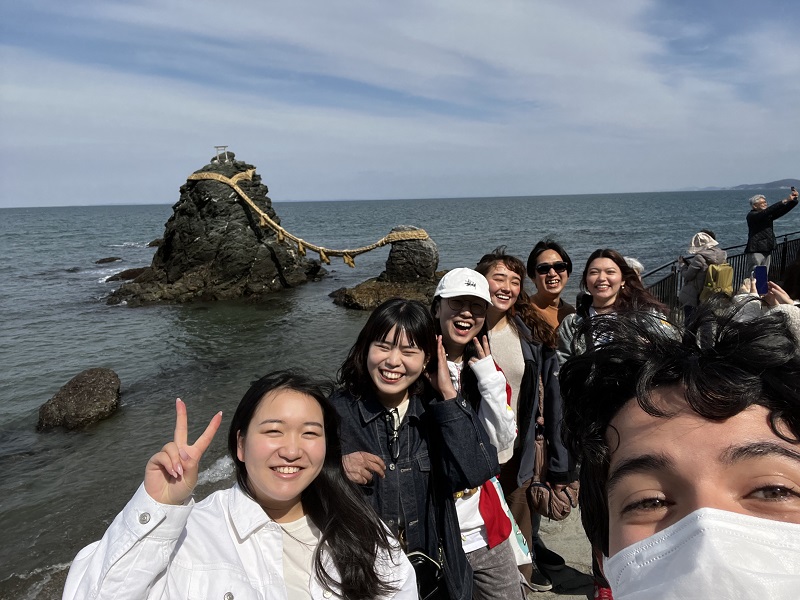
Group picture with Meoto Iwa, wedded rocks, in Mie.